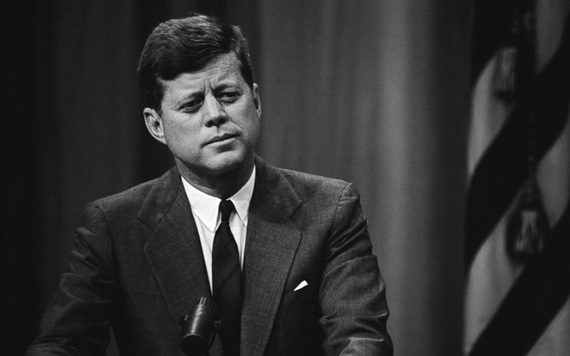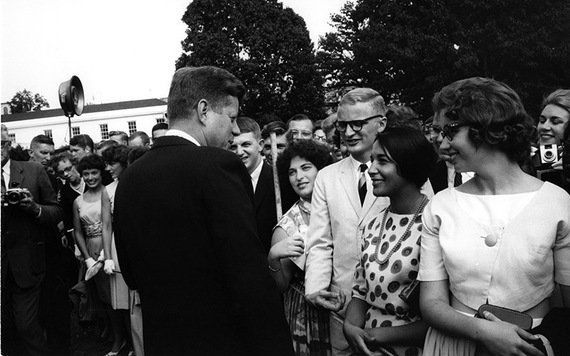In a speech at the University of Michigan in 1960, John F. Kennedy challenged US college graduates to volunteer in underprivileged countries for the cause of peace. A year later the Peace Corps was established.
Since March 1, 1961, 220,000 Americans have served in one of the most impactful lasting legacies of Irish American President John F. Kennedy: the Peace Corps.
Established on this day 18 years ago, the idea for the establishment of the international volunteer organization first came from an impromptu speech by JFK at the University of Michigan in 1960. From here he challenged Americans to better the world and strive toward peace by volunteering in countries less privileged, not just educate but to live alongside their people.
How the quotes from a University of Michigan speech prompted Kennedy to establish the Peace Corps?
On October 14, 1960, at 2:00 am, John F. Kennedy, then a presidential candidate, arrived at the University of Michigan in Ann Arbor expecting to get some sleep. Waiting for him, however, were 10,000 students eager to hear him speak.
It was here that he stood and challenged the students with an idea that has since captured the imaginations of thousands of Americans. He challenged them to give up pay or a salary for a period of time to volunteer in working towards peace overseas.
Quotes from the Michigan speech include:
"How many of you who are going to be doctors, are willing to spend your days in Ghana? Technicians or engineers, how many of you are willing to work in the Foreign Service and spend your lives traveling around the world?
“On your willingness to do that, not merely to serve one year or two years in the service, but on your willingness to contribute part of your life to this country, I think will depend the answer whether a free society can compete. I think it can!
“And I think Americans are willing to contribute. But the effort must be far greater than we have ever made in the past.”
Read more: John F Kennedy no longer has family links to County Cavan
How JFK established the Peace Corps?

President John F. Kennedy.
Just months later and now as the 35th President of the United States, John F. Kennedy signed an executive order on March 1, 1961, that established the Peace Corps and extended this challenge from Michigan to the rest of the US.
Three days later, R. Sargent Shriver became its first Director and by the end of that year, volunteers were serving in five countries. In just under six years, Director Shriver developed programs in 55 countries with more than 14,500 Volunteers.
The volunteers were enlisted for:
- Teaching in primary and secondary schools, especially as part of national English-language teaching programs.
- Participation in the worldwide program of malaria eradication.
- Instruction and operation of public-health and sanitation projects.
- Aiding in village development through school-construction and other programs.
- Increasing rural agricultural productivity by assisting local farmers to use modern implements and techniques.
Despite the lack of pay and tough conditions, many were willing to sign up for two or three years in the peace corps working on education of in agriculture.
JFK himself described it: "Life in the Peace Corps will not be easy. There will be no salary and allowances will be at a level sufficient only to maintain health and meet basic needs. Men and women will be expected to work and live alongside the nationals of the country in which they are stationed–doing the same work, eating the same food, talking the same language."
Read more: Immigration, JFK Vs Trump, welcome or go home
What was the first reaction to the Peace Corps?

John F. Kennedy established the Peace Corps in 1961.
US News questioned whether anybody would want to sign up but the US public was receptive from the start.
“Rafer Johnson, decathlon champion of the 1960 Olympic Games, was among the first to show interest,” they wrote on March 13, 1961.
“Early volunteers, put to work in the Peace Corps headquarters, were Sally Bowles, daughter of Under Secretary of State Chester Bowles, and Nancy Gore, daughter of Senator Albert Gore of Tennessee.
“Dr. Maurice L. Albertson of the Colorado State University Research Foundation, who headed a study of the Peace Corps idea, has estimated that at least 50,000 college graduates will volunteer each year.”
What does the Peace Corps do now?
The Peace Corps continues to work across the world, allowing US citizens, typically with a college degree, to provide technical assistance, helping people outside the United States to understand American culture, and helping Americans to understand the cultures of other countries.
Their global initiatives currently include the Let Girls Learn Initiative, the Stomping Out Malaria in Africa program, and the President's Emergency Plan for AIDS Relief (PEPFAR).
Have you ever volunteered with the Peace Corps? Tell us your story in the comments section below.




Comments